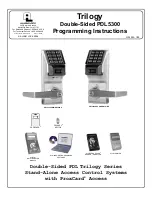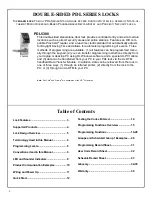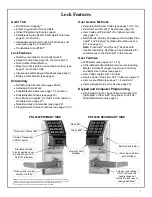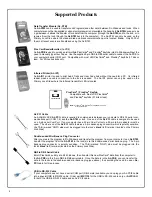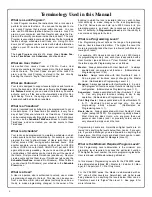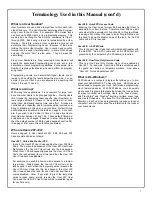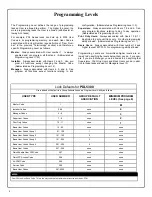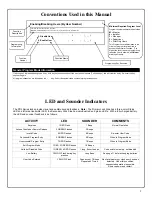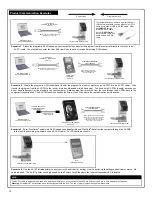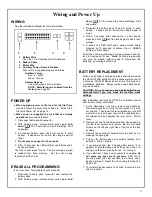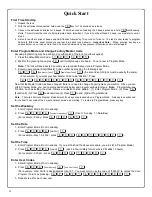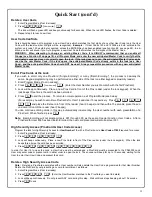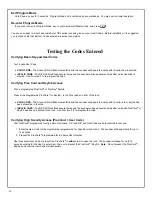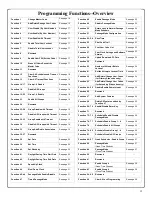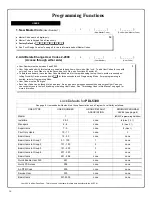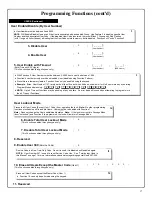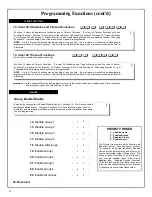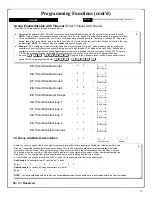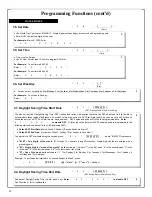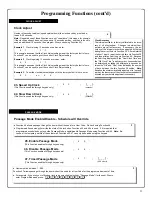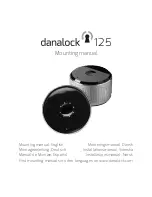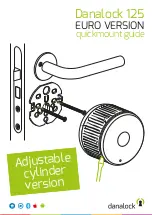
6
Terminology Used in this Manual
What is a
Lock Program
?
A Lock Program contains the instructions that a lock uses to
perform its various functions. You can use the keypad to cre-
ate a Lock Program that is stored within the lock. You can
also use DL-Windows (defined below) to create a Lock Pro-
gram on your computer, and then transfer and store the Pro-
gram in the circuitry contained inside the lock itself. The Lock
Program is essentially a computer database file that maintains
feature settings, schedules, audit trails, etc. Using DL Win-
dows, Lock Programs can be created with default information,
edited on your PC, and then sent to (and even received from)
locks.
The
Lock Program
consists of 4 areas:
User Codes
,
Fea-
tures
,
Time Zones
, and
Schedules
, all defined below:
What are
User Codes
?
Also called
User Access Codes
or
PIN No. Codes
, User
Codes are numbers the User presses into the lock keypad to
unlock the lock. The User Codes are part of the Lock Pro-
gram, and the Lock Program is stored in the lock circuitry
awaiting the Users to "key-in" their User Codes.
What are
Features
?
Your lock is designed to support several options and functions.
Using the keypad or DL-Windows software (the
Programma-
ble Features
window), you can select the features you wish to
activate, such as if the lock will automatically adjust for Day-
light Saving Time in the spring and autumn, or if the lock
sounder should be disabled or enabled.
What is a
TimeZone
?
Events (recorded lock activities) can be programmed to occur
at certain times. It is these times (for example, “every Tues-
day at 5pm”) that are referred to as
TimeZones
. TimeZones
can be created manually through the keypad. In DL-Windows,
you can use the
Schedule-TimeZone
screen to create these
TimeZones, and once created, you can link events to these
TimeZones.
What is a
Schedule
?
Your lock can be programmed to maintain a schedule in which
certain events can occur automatically. For example, you can
program the lock to allow Groups of Users (with their User
Codes) access ONLY during specific business hours. With
another example, you can program another lock to UNLOCK
at 9am, LOCK at noon for lunch, UNLOCK at 1pm, and LOCK
again at 5pm--every weekday. As you can see, many different
combinations of Schedules can be created to suit the needs of
the Users. First you create
TimeZones
(see above). Next you
create events and link them to your TimeZones (also using the
Schedule-TimeZone
screen in DL-Windows). When finished,
you can view (in DL-Windows) your schedule in the
Schedule
View
screen.
What is a
User
?
A User is a person who is authorized to unlock, use or make
programming changes to the lock. This User can be anyone--
from a one-time visitor (who will almost certainly have no au-
thority to make programming changes) to the owner of the
building in which the lock is installed (who may wish to have
total authority to make changes to the lock programming).
The PDL Series locks can hold up to 2000 Users in its pro-
gramming memory, and each User possesses a pre-defined
level of authority--a
Programming Level
--as to their ability to
use or make changes to the lock.
What is a
Programming Level
?
The Programming Level defines the range of programming
tasks a User is allowed to perform. The higher the Level, the
more programming tasks the User is allowed (with Master al-
lowing ALL tasks).
For example,
PDL Series
locks can hold up to 2000 Users in
its programming memory, and each User is associated with a
User Number (see definition of "User Number" below) and
therefore a specific Programming Level, as follows:
Master:
Always associated with User Number 1. Is always
enabled and can program all functions. (Abbreviated as
Programming Level = M).
Installer:
Always associated with User Numbers 2 and 3.
Can program all functions except changing the Master
Code. (Abbreviated as Programming Level = 4).
Manager:
Always associated with User Numbers 4, 5, and 6.
Can program all functions except functions relating to lock
configuration. (Abbreviated as Programming Level = 3).
Supervisor:
Always associated with User Numbers 7, 8 and
9. Can only program functions relating to day to day
operation. (Abbreviated as Programming Level = 2).
Print Only Users:
Always associated with User Numbers 10
& 11. Restricted to print event logs only. No other
programming ability allowed. (Abbreviated as
Programming Level = 1).
Basic Users:
Always associated with User Number 12 and
higher (except 297-300). No programming ability allowed.
Most Users are
Basic Users
, who are given their own
personal User Codes (and / or proximity cards) and are
only allowed to simply unlock the lock.
Programming Levels are hierarchical--higher levels are al-
lowed to do anything the levels below them can do. For exam-
ple, if you are a
Manager
, you are allowed to do anything that
Supervisors
,
Print-Only Users
and
Basic Users
can do in addi-
tion to those tasks allowed for Managers (Level 3).
What is the
Minimum Required Program Level
?
This Programming Level abbreviation is the
minimum
pro-
gramming level required to access the particular Function.
(The higher the level number, the more programming tasks the
User is allowed, with Master allowing all tasks).
In this manual, Programming Levels for the PDL5300 series
are abbreviated as follows:
M
= Master,
4
= Installer,
3
= Man-
ager,
2
= Supervisor,
1
= Print Only Users
For the PDL5300 series, the Master is abbreviated with an
"M", and all other Levels are hierarchical, with higher levels
being allowed to do anything the levels below them can do.
Therefore Level 4 is "higher" than level 3. See page 8 for
more information.

